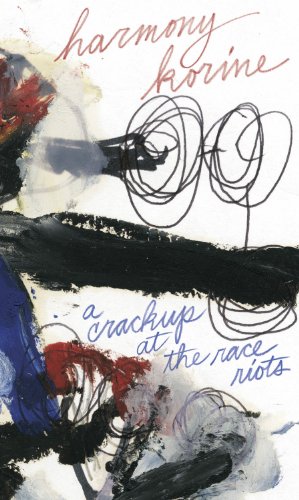
Before David Letterman banned him, the filmmaker Harmony Korine made three memorable appearances on CBS’s Late Show. On his first visit—in 1995, when he was 22—Korine came to promote Larry Clark’s Kids, for which he’d written the screenplay. When Letterman asked how one turns a script into a movie, a fidgety Korine, his voice cracking, replied, “Oh, I’m not sure.” The audience laughed, then broke into applause. He delighted them again in 1997, returning in a suit and V-neck sweater to plug his directorial debut, Gummo. (Letterman: “You’ve assembled a series of very striking, vivid, disturbing impressions.” Korine: “Yeah, well, that’s basically my style.” Big laugh.)
The next year Korine released A Crack-Up at the Race Riots, a fragmentary book of lists, jokes, and dialogue that includes a page titled “Idea for a Late-Night Comedy.” It consists of twelve steps:
1. Walk out onstage wearing a navy blue suit with a tight gray sweater underneath, like an English schoolboy.
2. Begin to play with the sleeve of my jacket, pull it back and forth and then stick my hand inside my coat pocket. (A few people in the audience will start to chuckle.)
3. Tell a two-minute monologue about getting my first haircut.
4. Smile a nervous grin at the audience. (The audience will fall into hysterical laughter. Note: By this time the audience should be completely won over.)
The instructions end with “Waltz offstage like Big Crosby.” Korine made his last trip to Letterman to promote Crack-Up, but this time he seemed more out of it than “pleasantly odd” (as the host introduced him), only getting off one decent joke—“I had to rent it,” he cracked, referring his hoodie, t-shirt and worn-out jeans—before disintegrating into mumbles. Now that he had a script for his sleeve-pulling goof, the deed suddenly became more dark and abstract. (Of course, he was also incredibly high, or seemed to be.) Letterman would later cancel a fourth appearance at the last minute, when he discovered Korine going through Meryl Streep’s purse backstage. Korine himself may have become a mess, but more to the point, his act proved fragile, too. He could only snooker the talk-show crowd for so long.
With his latest movie, Spring Breakers, Korine has delved deeper than ever into the mainstream, this time with an air of confidence. Which makes A Crack-Up at the Race Riots—now available in a fresh edition unburdened by a new foreword or any other analytical cruft—all the more fascinating, showing the artist at his most stunt-y and stunted. The book’s jottings, some of which actually appear to be photocopied from Korine’s (boyishly neat) handwritten notes, read like a disaffected teen’s deliberately un-P.C. journaling, toying with racism, homophobia, rape, molestation, drug use, suicide and the Holocaust—but filtered through an absurd, sometimes archaic pop-culture sensiblity. Al Jolson, John Candy, and Tupac populate gags for a post-apcalyptic Borscht Belt. The double-groaner “Incest is relative”? Credited to Fred Astaire.
Crack-Up itself prods the limits of black humor—of humor itself, really. On one page, a barber offers a detailed description of a mullet. There’s a joke about Annie Lennox working as a “fish filleter” (to “practice her scales”). A conversation between “Fag Basher 1” and “Fag Basher 2” starts with the two casually identifying a “homo” acquaintance and ends with an exchange about Crocodile Dundee.
None of this would play in Peoria, and it’s too crude for the coasts. But Crack-Up feels uncomfortably of-the-moment. It’s like a satirist’s pre-cognition of internet trolling, inane rankings, pointless nostalgia, rampant rumor-mongering, and arbitrary celebrity worship. Reading the book now, you can detect hints of Family Guy (which debuted in ’99), Buzzfeed lists, Reddit theorizing, “Weird Twitter,” Facebook flame-wars and workday Google Chats. In a way, Korine’s miniature media dystopia—devised in the ’90s, when the status quo still demanded some tearing down—has come to life. (And of course, Korine’s Letterman interviews have become YouTube hits.) That it’s so entertaining should no longer come as a surprise. In his blurb for the first edition, Jim Carroll called Korine “the new heir, the man, the sweet edge of the future.” Like many blurbs, it’s a laughable bit of hyperbole. But “sweet” may be the only part Carroll got wrong.
Nick Catucci is the head of programming for Popdust and writes for Rolling Stone.